Curcuma
Between Bossman Chris Beytes and I, we’ve mentioned curcuma two (maybe even three) times in our various newsletters in the last two months. I’m going to make it a third (or maybe a fourth).
I had a call with Suzanne Kilgore, product and program development manager at ForemostCo this week, thanking me and Chris for mentioning the company’s quite popular Siam series of curcuma. She also reminded me (and thereby all of you) that ForemostCo has essentially dominated the curcuma market in the U.S. for about 30 years. “We’ve had it forever, and for the longest time, we were the only game in town,” Suzanne said. “From what I’ve seen so far, we are still pretty well in control of the market.”
ForemostCo works with the Dutch breeders KP Holland, and they sourced their original genetic material from Thailand and have had the entire breeding program in house, in Holland, for many years. KP Holland started with two colors from tissue culture and through their breeding efforts have nearly 10 more. ForemostCo currently has 11 varieties (Sanna and Salsa are their latest), adding about two new varieties each year. KP is breeding not just for different colors and flower sizes but also for faster finishing times, compact sizes and taller varieties, giving growers options for what they want to do with them.
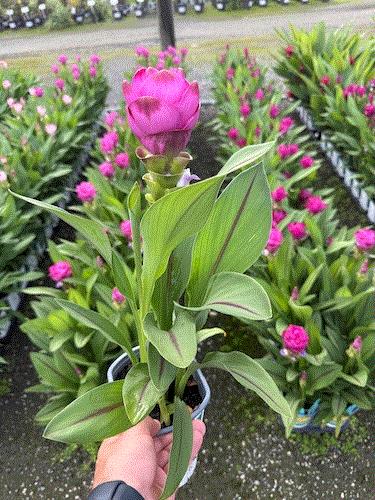
Sanna

Salsa
“When they’re testing the waters, they send us tissue culture and we grow out a few trays, and we get them out to some growers to see how they do,” Suzanne said, “because the difference between how they do in Europe and even how they perform in different conditions in North America can be different.” How so, I asked. “They can present as different colors. We have a new variety this year called Salsa, and in Europe, it’s kind of a whitish, light pink flower with vibrant red tips. And here, it can look washed out, depending on condition. I just saw some that were grown in higher light and they are vibrant and beautiful (see below). They are nothing like the first ones I saw. Looks like a winner to us!”
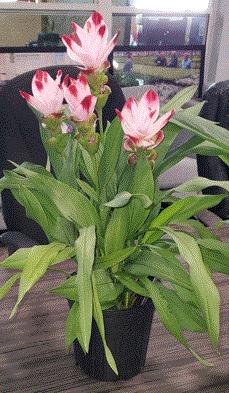
Salsa grown in higher light conditions
What accounts for the difference? Suzanne believes it could be light intensity. Because it’s much darker in Holland than in the southern U.S., they grow them in greenhouses under lights there—at least 13 hours of lighting. I’m told it’s the total light that is key to growing curcuma. Florida has more light intensity, so growers there can get away with at least 12 hours of light, whereas more northerly locations need 13-14 hours.
Another thing I didn’t know about curcuma is that some varieties have fatter leaves and some have thinner—and the fatter-leaved varieties grow significantly faster—finished in eight to nine weeks in a 6-in. pot, according to Suzanne—compared to the thinner-leaved varieties that take about 10-14 weeks. Regardless of fatter or thinner, Suzanne says curcuma is “a good return on investment. Everybody makes good money off these, even the finished grower, because the crop is finished so fast. If you’re an annual grower, that’s not so fast but for a foliage grower, that’s real fast.”
I do think curcuma are exotically tropical in a jungle-y sort of way and underused as a tropical annual in northern climes. If you’d like to learn more about curcuma and specifically the Siam series offered by ForemostCo, check out their offerings HERE.

Speaking of Jungle-y
Dümmen Orange just released the 2026 catalog for its Welcome to the Jungle indoor succulent and foliage houseplant program. The collection has more than 80 varieties of the most popular categories.
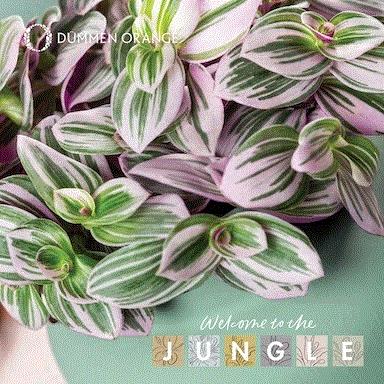
What are some of their most popular? Tradescantia Nanouk, which happens to be the most highly sought after variety within the Tradescantia class. And Dümmen has expanded availability of it, too. With its minty green, pink and magenta coloration and larger dense stems than other Tradescantias, Nanouk makes a wonderful houseplant. Don’t count it out as an outdoor plant, too! Add it to shade combinations in your outdoor annuals program for something fun and new.
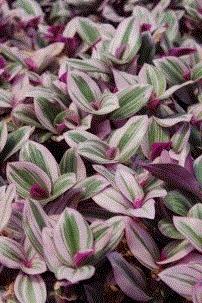
Tradescantia Nanouk
On the succulent side of things, Dümmen has added five new echeveria for 2026, including Blue Jay, Blue Lola, Emerald Ocean, Rainy Day and Tamasopo.
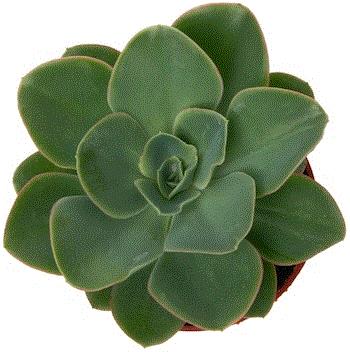
Echeveria Emerald Ocean
Succulents and foliage can be grown just about anywhere, so the Welcome to the Jungle Program can slip right into your growing schedule anywhere throughout the U.S. and Canada. And any of the 80 varieties will give you a relatively quick (as foliage goes) crop time of 10-14 weeks in 4- to 6-in. pots. And they are low on the water use requirements, too, so that’s good for keeping your resources down.
Welcome to the Jungle varieties are sourced from Dümmen’s farm in Antigua, Guatemala, which supplies high-quality clean unrooted cuttings, each packaged according to the variety’s individual needs for the healthiest cuttings possible. For more information and to explore all the varieties featured in the 2026 Welcome to the Jungle program, click HERE to view the new catalog online. Ready to order? Contact your preferred broker representative.

Webinar Alert!
Interior plantscapers, AmericanHort has a webinar for you coming up on Wednesday, August 20, 2-3 p.m. It’s titled “Bridging the Gap: Strengthening Sales & Operations Communications” and will help your teams to deliver better client experiences.
In this interactive AmericanHort Interior Plantscape and Landscape Community Connector Roundtable, industry consultant and leadership coach Neal Glatt will share actionable tactics and strategies to improve communication, enhance teamwork and reduce costly misalignments between sales and operations departments. The folks who will benefit from this Community Roundtable include:
-
Interior plantscape professionals
-
Landscape business owners and managers
-
Sales and operations leaders
-
Other professionals interested in elevating team performance
While this webinar is targeted to interiorscapers and landscapers, all AmericanHort members are welcome to attend. Can’t attend live? No worries! If you register beforehand, you’ll be notified when the recorded version is ready for viewing.
Find out more about this webinar and register HERE.

Dissing On Snake Plant
I read (and write) a lot of consumer-oriented pieces along the lines of “The 10 Best Plants for XYZ”, but I had never come across a piece that focused on all the reasons not to grow something. Until now.
The folks at House Digest saw fit to give readers 10 reasons not to grow Sansevieria, especially if you’re a beginner. “While we agree that they’re pretty forgiving,” they piece stated, “there's more behind that resilient facade that should make you think twice before picking one up.”
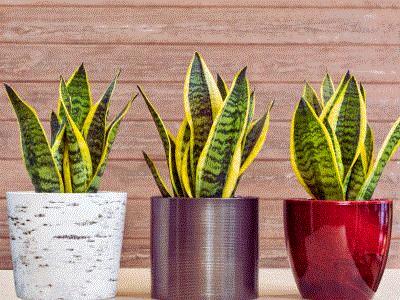
What could these 10 reasons possibly be?
-
It’s a slow grower
-
It’s susceptible to rot and overwatering
-
It doesn’t like your dark, windowless room
-
They can become top-heavy
-
Extra cost for well-draining succulent mix and amendments
-
Its leaves can be super sharp and pointy
-
It’s considered toxic to humans and pets
-
Any leaf damage is often permanent
-
They can break your beloved plant pots
-
It’s not easy to control if you grow it outside
I think the author was grasping at straws near the end—not to mention the cattiness that crept into the piece, too. For instance, under the “permanent leaf damage” concern, it said “If your snake plant gets damaged, the only thing you can really do is just live with it and be glad it’s still alive. Even if you trim off the damage, the leaf won't grow any further, leaving you with a stubby reminder of whatever happened.” Yikes!
To the article’s credit, however, the author did include alternative plants to “mitigate the migraines” but with a plant that has a similar look, such as a ZZ plant, cast iron plant or the pencil cactus. Read the whole piece HERE.
My point here is that I wanted to make you aware of this smear campaign against Sansevieria. And also, encourage you to make Sansevieria’s weaknesses into its strengths in any sort of consumer marketing or social posts. It’s a darn good plant—be its champion!
If you have any comments, questions or suggestions for content, email me about them at ewells@ballpublishing.com.

Ellen Wells
Senior Editor
Green Profit
This edition of Tropical Topics was sent to 28,958 loyal readers!
If you're interested in advertising on Tropical Topics, contact Kim Brown ASAP!